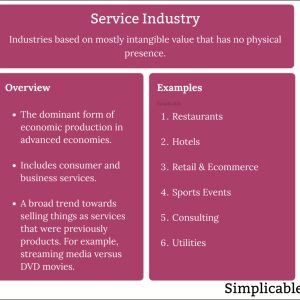What exactly is the service industry? In short, it’s a vast and essential sector of the economy that encompasses any business or organization that provides services rather than physical goods. These services can range from healthcare and education to hospitality and transportation.
Editor’s Note: The service industry is more important than ever before. In today’s knowledge economy, businesses are increasingly relying on service providers to help them stay competitive. As a result, the service industry is growing rapidly and is expected to continue to grow in the years to come.
To help you understand the service industry, we’ve put together this guide. It covers everything you need to know about this important sector of the economy, including its key trends, challenges, and opportunities.
Key Differences:
| Goods-Producing Industry | Service Industry |
|---|---|
| Produces tangible products | Provides intangible services |
| Examples: manufacturing, mining, agriculture | Examples: healthcare, education, hospitality |
| Typically involves physical labor | Typically involves mental labor |
Key Takeaways:
- The service industry is a major part of the economy, accounting for over 80% of GDP in developed countries.
- The service industry is growing rapidly, due to the increasing demand for services in the knowledge economy.
- The service industry is a major source of jobs, employing over 70% of the workforce in developed countries.
The service industry is a complex and diverse sector of the economy. It includes a wide range of businesses and organizations, each with its unique set of challenges and opportunities. In this guide, we’ll explore the service industry in more detail, covering the following topics:
- The different types of service industries
- The key trends shaping the service industry
- The challenges facing the service industry
- The opportunities for growth in the service industry
We hope this guide provides you with a comprehensive understanding of the service industry. If you have any questions, please don’t hesitate to contact us.
The Service Industry
The service industry is a vast and essential sector of the economy that encompasses any business or organization that provides services rather than physical goods. These services can range from healthcare and education to hospitality and transportation.
- Intangibility: Services cannot be touched or held, unlike physical goods.
- Heterogeneity: Services can vary greatly in quality, even within the same industry.
- Perishability: Services cannot be stored or inventoried, so they must be produced and consumed at the same time.
- People-oriented: Services are typically provided by people, rather than machines.
- Customer interaction: Customers play an active role in the production of services.
- Regulation: The service industry is heavily regulated, due to the potential for consumer harm.
- Technology: Technology is playing an increasingly important role in the service industry.
These seven key aspects of the service industry highlight its importance and complexity. Services are essential for our economy and our daily lives. They provide us with everything from healthcare and education to food and entertainment. The service industry is also a major source of jobs, employing over 70% of the workforce in developed countries.
Suggested read: Comprehensive Guide to the Service Industry Definition
As the service industry continues to grow, it is important to understand its unique characteristics and challenges. By doing so, we can ensure that this vital sector of the economy continues to thrive.
Intangibility
The intangibility of services is one of the key characteristics that distinguishes them from physical goods. Services cannot be touched, held, or stored in inventory. This can make it difficult for customers to evaluate the quality of a service before purchasing it, and it can also lead to challenges in marketing and pricing services.
However, the intangibility of services can also be a source of competitive advantage. Because services cannot be easily copied or imitated, businesses that can develop and deliver unique and valuable services can create a sustainable competitive advantage.
For example, a consulting firm that provides specialized advice to businesses may have a competitive advantage over a firm that sells software products. The consulting firm’s services are intangible, but they can be highly valuable to businesses that need help solving complex problems.
Another example is a software company that provides cloud-based services. The company’s services are intangible, but they can be highly valuable to businesses that need to access software applications and data from anywhere in the world.
The intangibility of services is a key challenge for businesses in the service industry. However, it can also be a source of competitive advantage. Businesses that can develop and deliver unique and valuable services can create a sustainable competitive advantage in the marketplace.
Table: Intangibility of Services
| Challenges | Opportunities |
|---|---|
| Difficult for customers to evaluate quality before purchasing | Competitive advantage through unique and valuable services |
| Challenges in marketing and pricing services | Services cannot be easily copied or imitated |
Heterogeneity
The heterogeneity of services is one of the key characteristics that distinguishes them from physical goods. Services can vary greatly in quality, even within the same industry. This can make it difficult for customers to compare services and choose the best option for their needs.
- Customer expectations: Customers’ expectations for services can vary greatly, depending on their individual needs and experiences. For example, some customers may expect a high level of personalized service, while others may be more concerned with price or convenience.
- Provider capabilities: The quality of a service can also vary depending on the capabilities of the provider. For example, a doctor with more experience and expertise is likely to provide a higher quality of service than a doctor with less experience.
- Service delivery: The way in which a service is delivered can also affect its quality. For example, a restaurant that provides excellent customer service and a high-quality dining experience is likely to be rated more highly than a restaurant that provides poor service and a mediocre dining experience.
- External factors: External factors, such as the weather or the economy, can also affect the quality of a service. For example, a hotel that is located in a desirable location and has a good reputation is likely to be rated more highly than a hotel that is located in a less desirable location and has a poor reputation.
The heterogeneity of services can be a challenge for both customers and providers. However, it can also be an opportunity for providers to differentiate themselves from their competitors and to create a loyal customer base.
Perishability
The perishability of services is a key characteristic that distinguishes them from physical goods. Services cannot be stored or inventoried, so they must be produced and consumed at the same time. This can create challenges for businesses in the service industry, but it can also be an opportunity to create a competitive advantage.
One of the biggest challenges of perishability is that it can make it difficult to manage supply and demand. For example, a restaurant cannot produce more food than it expects to sell on a given day, because the food will go to waste. This can lead to lost sales if demand is higher than expected, or to waste if demand is lower than expected.
Another challenge of perishability is that it can make it difficult to scale a service business. For example, a consulting firm cannot simply hire more consultants to meet increased demand, because the consultants must be available to provide services to clients at the time the services are needed.
However, the perishability of services can also be an opportunity for businesses to create a competitive advantage. For example, a restaurant can use its perishability to create a sense of urgency and excitement. By offering fresh, made-to-order food, a restaurant can create a dining experience that is more memorable and enjoyable for customers.
Similarly, a consulting firm can use its perishability to create a sense of exclusivity and value. By providing customized services that are tailored to the specific needs of each client, a consulting firm can create a service offering that is more valuable and differentiated than that of its competitors.
The perishability of services is a key characteristic that businesses in the service industry must understand and manage. By understanding the challenges and opportunities of perishability, businesses can develop strategies to create a competitive advantage and succeed in the marketplace.
Table: Perishability of Services
| Challenges | Opportunities |
|---|---|
| Difficult to manage supply and demand | Create a sense of urgency and excitement |
| Difficult to scale a service business | Create a sense of exclusivity and value |
People-oriented
The service industry is people-oriented. This means that services are typically provided by people, rather than machines. This is because services are often intangible and require a human touch. For example, a doctor provides a medical service by examining a patient and providing a diagnosis. A teacher provides an educational service by instructing students and providing feedback. A waiter provides a hospitality service by serving food and drinks to customers.
The people-oriented nature of the service industry has a number of implications. First, it means that service providers must have strong interpersonal skills. They must be able to communicate effectively with customers, understand their needs, and build relationships with them. Second, it means that service providers must be able to adapt to the needs of individual customers. No two customers are the same, so service providers must be able to tailor their services to meet the specific needs of each customer.
The people-oriented nature of the service industry also has a number of benefits. First, it allows service providers to build strong relationships with their customers. This can lead to repeat business and increased customer loyalty. Second, it allows service providers to provide a more personalized service. This can make customers feel more valued and appreciated.
The people-oriented nature of the service industry is a key factor in its success. By providing personalized and responsive services, service providers can build strong relationships with their customers and create a loyal customer base.
Table: The People-oriented Nature of the Service Industry
Suggested read: What is the Service Industry - A Comprehensive Guide
| Challenges | Opportunities |
|---|---|
| Requires strong interpersonal skills | Build strong relationships with customers |
| Must be able to adapt to the needs of individual customers | Provide a more personalized service |
Customer interaction
In the service industry, customer interaction is not just a passive exchange of goods or services. It is an active and essential part of the production process. Customers are not simply recipients of services; they are co-creators of value.
Consider the example of a restaurant. The customer’s role in the production of the meal begins long before they arrive at the restaurant. They choose the restaurant, based on factors such as location, reputation, and menu. They decide what to order, and they may even customize their order to meet their specific needs. Once the food is served, the customer’s role continues. They eat the food, and they provide feedback to the server. This feedback helps the restaurant to improve its service and menu.
The customer’s role in the production of services is not limited to restaurants. In healthcare, patients play an active role in their own treatment. They provide information about their symptoms, they follow doctor’s orders, and they make lifestyle changes to improve their health. In education, students play an active role in their own learning. They ask questions, they participate in discussions, and they complete assignments.
The importance of customer interaction in the service industry cannot be overstated. Customers are not simply passive recipients of services; they are active participants in the production process. Businesses that understand this and that focus on creating positive customer interactions are more likely to succeed in the long run.
Table: The Importance of Customer Interaction in the Service Industry
| Benefits of Customer Interaction | Examples |
|---|---|
| Improved service quality | Customers can provide feedback that helps businesses to improve their service. |
| Increased customer satisfaction | Customers are more satisfied when they feel like they are actively involved in the production of services. |
| Greater customer loyalty | Customers are more likely to be loyal to businesses that they feel a connection to. |
| Increased revenue | Businesses that focus on customer interaction are more likely to generate repeat business and increase revenue. |
Regulation
The service industry is heavily regulated due to the potential for consumer harm. This is because many services can have a direct impact on the health, safety, and financial well-being of consumers. For example, healthcare services can affect a person’s health and even their life. Financial services can affect a person’s financial security. Transportation services can affect a person’s safety. As a result, governments have enacted a wide range of regulations to protect consumers from potential harm.
- Protecting consumers from fraud and abuse
One of the main reasons for regulation in the service industry is to protect consumers from fraud and abuse. For example, regulations require financial advisors to disclose their fees and conflicts of interest. This helps to ensure that consumers are not misled or taken advantage of.
Ensuring the safety of services
Another reason for regulation in the service industry is to ensure the safety of services. For example, regulations require hospitals to meet certain safety standards. This helps to ensure that patients are not exposed to unnecessary risks.
Maintaining the quality of services
Regulation can also help to maintain the quality of services. For example, regulations require schools to meet certain educational standards. This helps to ensure that students receive a quality education.
Promoting competition and innovation
Regulation can also promote competition and innovation in the service industry. For example, regulations that prevent monopolies can help to ensure that consumers have access to a variety of choices. Regulations that encourage research and development can help to drive innovation in the service industry.
Regulation is an important part of the service industry. It helps to protect consumers from harm, ensure the safety of services, maintain the quality of services, and promote competition and innovation. As the service industry continues to grow, it is important to have a strong regulatory framework in place to protect consumers and ensure the continued growth of the industry.
Technology
Technology is transforming the service industry in a number of ways. From the way services are delivered to the way customers interact with businesses, technology is having a profound impact. Here are a few of the ways that technology is playing an increasingly important role in the service industry:
-
Automation
Technology is automating many tasks that were once performed by humans. This is freeing up service providers to focus on more complex and value-added tasks. For example, in the healthcare industry, technology is being used to automate tasks such as scheduling appointments, processing insurance claims, and dispensing medication. This is allowing doctors and nurses to spend more time with patients, providing higher quality care. -
Self-service
Technology is also making it easier for customers to self-serve. This is reducing the need for human interaction, which can save businesses time and money. For example, in the retail industry, self-checkout kiosks are becoming increasingly common. This allows customers to scan and pay for their own groceries without having to wait in line for a cashier. -
Personalization
Technology is also allowing businesses to personalize their services to individual customers. This is being done through the use of data analytics and artificial intelligence. For example, in the hospitality industry, hotels are using data analytics to personalize the guest experience. This includes things like offering customized recommendations for activities and restaurants, and providing personalized in-room amenities. -
Remote delivery
Technology is also making it possible to deliver services remotely. This is opening up new opportunities for businesses to reach customers who may not have been able to access their services in the past. For example, in the education industry, online learning is becoming increasingly popular. This is allowing students to access educational resources from anywhere in the world.
These are just a few of the ways that technology is playing an increasingly important role in the service industry. As technology continues to develop, we can expect to see even more innovation and transformation in the years to come.
Frequently Asked Questions about the Service Industry
The service industry is a vast and complex sector of the economy that encompasses a wide range of businesses and organizations. As such, there are many common questions and misconceptions about the service industry.
Question 1: What exactly is the service industry?
Answer: The service industry is any industry that provides services rather than physical goods. Services can range from healthcare and education to hospitality and transportation.
Question 2: What are the key characteristics of the service industry?
Suggested read: Instant, Accurate Service Quotes - Get Your Project Started Today!
Answer: The key characteristics of the service industry include intangibility, heterogeneity, perishability, people-orientedness, customer interaction, regulation, and technology.
Question 3: What are the benefits of using services?
Answer: Services can provide a number of benefits, including convenience, expertise, and customization. Services can also help to free up time and resources.
Question 4: What are the challenges facing the service industry?
Answer: The service industry faces a number of challenges, including competition, regulation, and technology. However, the service industry is also constantly evolving and adapting to new challenges.
Question 5: What is the future of the service industry?
Answer: The future of the service industry is bright. The service industry is expected to continue to grow in the years to come, driven by increasing demand for services from both consumers and businesses.
Question 6: How can I get involved in the service industry?
Answer: There are many ways to get involved in the service industry. You can start by volunteering for a non-profit organization or working part-time in a service-oriented business. You can also pursue a degree or certification in a service-related field.
Summary of key takeaways or final thought: The service industry is a vital part of the economy and our daily lives. Services provide us with everything from healthcare and education to hospitality and transportation. The service industry is constantly evolving and adapting to new challenges. The future of the service industry is bright, and there are many opportunities to get involved in this exciting and growing sector.
Transition to the next article section: To learn more about the service industry, please see our other articles on this topic.
Tips for Succeeding in the Service Industry
The service industry is a vast and competitive field, but there are a number of things you can do to increase your chances of success. Here are five tips to help you get started:
Tip 1: Be passionate about serving others.
The best service providers are those who are genuinely passionate about helping others. If you don’t enjoy serving others, it will be difficult to provide excellent customer service.
Tip 2: Be knowledgeable about your products or services.
Customers will be more likely to trust you and do business with you if they believe that you know what you’re talking about. Take the time to learn about your products or services so that you can answer customer questions confidently.
Tip 3: Be responsive to customer needs.
Customers want to feel like they are being heard and that their needs are important to you. Make sure to respond to customer inquiries promptly and courteously. Go the extra mile to resolve customer complaints and ensure that they are satisfied with your service.
Suggested read: User-Friendly Service Project Ideas for the Service-Minded
Tip 4: Be professional and courteous.
Customers want to feel respected and valued. Always be polite and professional, even when dealing with difficult customers. Dress appropriately and maintain a positive attitude.
Tip 5: Be proactive.
Don’t wait for customers to come to you. Be proactive in seeking out new business and building relationships with potential customers. Network with other businesses in your community and get involved in local events.
Summary of key takeaways or benefits: By following these tips, you can increase your chances of success in the service industry. Remember to be passionate about serving others, be knowledgeable about your products or services, be responsive to customer needs, be professional and courteous, and be proactive. By providing excellent customer service, you can build a loyal customer base and achieve long-term success.
Transition to the article’s conclusion: For more tips and advice on succeeding in the service industry, please see our other articles on this topic.
The Service Industry
Our exploration of the service industry has revealed its multifaceted nature and profound impact on our daily lives. From healthcare and education to hospitality and transportation, services play a vital role in meeting our needs and enhancing our well-being.
The unique characteristics of the service industry, such as intangibility, heterogeneity, and perishability, create both opportunities and challenges for businesses. By understanding these characteristics and adapting to the evolving demands of customers, service providers can differentiate themselves and achieve success.
The future of the service industry is bright. As technology continues to advance and customer expectations rise, service providers must embrace innovation and personalization to remain competitive. By investing in their people, processes, and technology, service businesses can create value for customers and drive economic growth.
Youtube Video:






